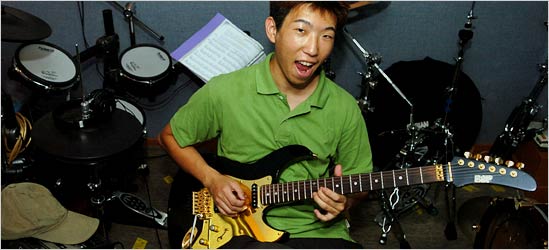 Airbus A380
Airbus A380The Airbus A380 is a double-decker, four-engined airliner manufactured by Airbus S.A.S. It first flew on April 27, 2005, from Toulouse, France. Commercial flights should begin in 2006 after 15 months of testing. During much of its development the aircraft was known as the Airbus A3XX.
The A380 is now the largest passenger airliner, topping the Boeing 747, which was the largest for 35 years. However, the Antonov An-225 retains the record of being the world's largest commercial aircraft. The media has termed the A380 a "superjumbo". The first A380 prototype was unveiled during a ceremony in Toulouse, on January 18, 2005. Its manufacturer's serial number is 001, and is registered as F-WWOW.
DesignThe new Airbus will initially be sold in two versions: the A380-800, carrying 555 passengers in a three-class configuration or up to 800 passengers in a single-class economy configuration. Expected range for the -800 model is 8,000 nautical miles (14,800 km). The second model, the A380-800F dedicated freighter, will carry 150 tonnes of cargo 5,600 nautical miles (10,400 km).
CockpitMockup of the flight deck. Airbus made the cockpit layout, procedures, and handling characteristics similar to those of other Airbus aircraft to reduce crew training costs. Accordingly, the A380 features a glass cockpit and side-stick flight controller driving the airplane by fly-by-wire technology.
EnginesEither the Rolls-Royce Trent 900 or Engine Alliance GP7200 turbofan engines will power the A380. The Rolls-Royce Trent, the launch engine, initially gained most sales. However, the Engine Alliance GP7201 sales grew, now roughly matching those of the Trent 900.
AmenitiesInitial publicity has stressed the A380's space and comfort, allowing for relaxation areas, bars, duty free shops, and the like. The only A380 customer likely to order such is Virgin Atlantic, which has a bar in business class on most of its newer airliners and announced plans to include casinos on their A380s. Similar items were proposed in the past when large aircraft were announced but airlines have always opted for more seats to lower ticket costs. Given the history of the airline industry, the A380 will significantly expand the improvements that the 747 made, more seats and lower seat-distance costs, while providing wider seats and better amenities. With 555 passengers, the A380 represents a 35 % increase over the 747-400 in standard three-class configuration, along with a nearly 50% larger cabin volume meaning much more space per passenger. Some airports have planned terminal reconfigurations to facilitate loading and unloading from the A380's double decker design.
ConstructionAirbus operates 16 manufacturing sites across Europe, most of which produce parts for the new A380 airliner. First, the front and rear sections of the fuselage are loaded on an Airbus RORO ship, Ville de Bordeaux, in Hamburg, northern Germany, and are shipped to the United Kingdom. There the huge wings, which are manufactured at Filton in Bristol and Broughton in north Wales, are transported by barge to Mostyn docks where the ship adds them to its cargo. In Saint-Nazaire, western France, the ship trades the fuselage sections from Hamburg for larger, assembled sections, some of which include the nose. The ship unloads in Bordeaux. Afterwards, the ship picks up the belly and tail sections in Cadiz, southern Spain, and delivers them to Bordeaux.
From there the A380 parts are transported by barge to Langon, and by road to an assembly hall in Toulouse. New wider roads, extra canal systems, and barges were developed to deliver the massive A380 parts. After assembly the aircraft are flown to Hamburg to be furnished and painted. Final assembly began in 2004, with first aircraft (MSN001) displayed in January 2005.
HistoryBefore starting the A380 project both Airbus and Boeing had focused on cornering the very-large-airliner market. Airbus and Boeing had worked together on a study investigating a 600+ seat aircraft called the Very Large Commercial Transport, but this cooperation did not last long. Although both manufacturers issued various statements, the unspoken consensus was that there was probably room for only one maker to be profitable in the 600 to 800 seat market segment. Both knew the risk of splitting a niche market.
The simultaneous debut of the Douglas DC-10 and the Lockheed Tristar had demonstrated this: either aircraft could technically fill the gap between the Douglas DC-8 and the Boeing 747, but the market could only sustain one of the two. Eventually both companies left the civil airliner market. Boeing and Airbus decided to enter the new 600 seat market.
Boeing initially had the upper-hand. The 747, though designed in the 1960s, was popular and larger than Airbus' largest jet, the A340. For many airlines the extra size of the 747 made it a "must buy" for their highest density routes and the lower costs of a common fleet led carriers to buy additional Boeing aircraft. Boeing was considering a New Large Aircraft to replace the 747 and acquired McDonnell Douglas and their cancelled MD-12 design. Boeing studied the concept of the 747X, a version of the 747 with the forebody "hump" extended towards the rear for more passenger room, before dropping the concept. Development of the "A3XX" began in June, 1994. In 2001, it was re-branded the A380 with the announcement of Singapore Airlines as the launch customer.
DevelopmentAfter years of research Airbus decided to proceed with the 8.8 billion A380 project in 1999, the final budget settling at about 12 billion. The double-decker layout would provide higher seat capacities and, hence, cost savings over a traditional design.
The A380's wing has been designed to cope with a MTOW of 590t, albeit with some strenghtening required, allowing for a future stretch. The stronger wing and structure is used on today's freighter version, the A380-800F. This approach sacrifices some fuel efficiency on the initial passenger model but the sheer size of the aircraft coupled with the significant advances in technology over the years should provide lower operating costs per passenger than the 747.
Maiden flightThe airliner took off for its maiden flight at 8:29 UTC (10:29 a.m. local time) on April 27, 2005, from runway 32L of Blagnac International Airport in Toulouse, France, taking off with a flight crew of six, 22 tons of flight test instrumentation and water ballasts.
The crew was made up of French test pilots Jacques Rosay (captain for the take-off and the initial part of the test flight) and Claude Lelaie (captain for the second part of the test flight including the landing), as well as three flight test engineers (Spanish, French, and German), and one French test flight engineer. With the recent Franco-German controversy over the leadership of EADS still fresh in mind, Airbus issued a statement to make it clear that the crew had been chosen not based on nationality, but based on competence.
The takeoff weight of the aircraft was 421 tonnes (464 US tons), or about 75 % of its maximum takeoff weight for commercial flights. This was the heaviest takeoff weight of any passenger airliner ever created. After takeoff the jet headed west toward the Bay of Biscay, then south over the northern Pyrenees Mountains and concluded with a low altitude fly-by over the town of Toulouse. The 233 minute flight involved conducting tests on its engines, hydraulics, and electronics, while the on-board test equipment recorded measurements for 150,000 different parameters and sent data back to computers on the ground. The A380 now faces another year of in-flight testing before formal certification and commercial use.
OrdersSixteen airlines have ordered the A380 as of June 18, 2005, including an order from AIG's aircraft leasing unit, ILFC. Currently, A380 orders stand at 159, including 27 freighter versions. Break-even is estimated to be at 250 to 300 units. Airbus CEO, Noel Forgeard, has said he expects to sell 750 of the aircraft. Official prices have been withheld but it is estimated at $264 million. Carriers often receive large discounts for volume or early purchases.























































